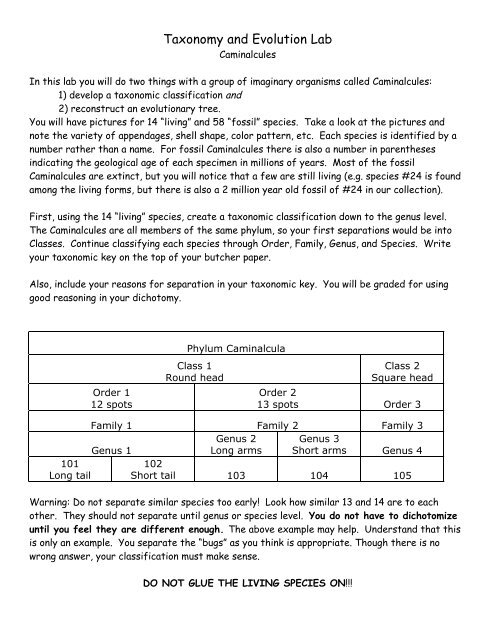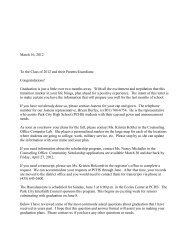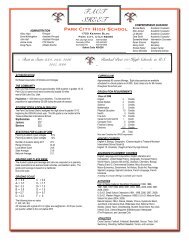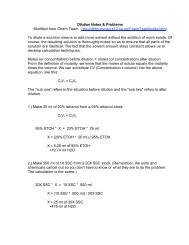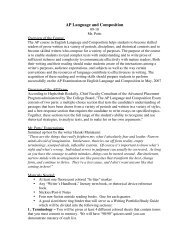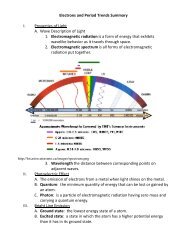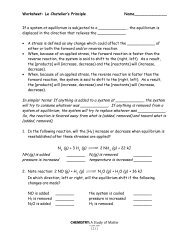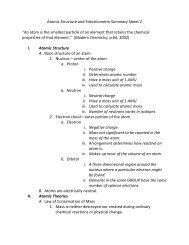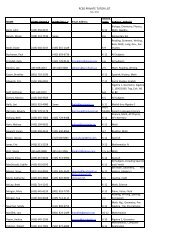Taxonomy and Evolution Lab
Taxonomy and Evolution Lab
Taxonomy and Evolution Lab
You also want an ePaper? Increase the reach of your titles
YUMPU automatically turns print PDFs into web optimized ePapers that Google loves.
<strong>Taxonomy</strong> <strong>and</strong> <strong>Evolution</strong> <strong>Lab</strong><br />
Caminalcules<br />
In this lab you will do two things with a group of imaginary organisms called Caminalcules:<br />
1) develop a taxonomic classification <strong>and</strong><br />
2) reconstruct an evolutionary tree.<br />
You will have pictures for 14 “living” <strong>and</strong> 58 “fossil” species. Take a look at the pictures <strong>and</strong><br />
note the variety of appendages, shell shape, color pattern, etc. Each species is identified by a<br />
number rather than a name. For fossil Caminalcules there is also a number in parentheses<br />
indicating the geological age of each specimen in millions of years. Most of the fossil<br />
Caminalcules are extinct, but you will notice that a few are still living (e.g. species #24 is found<br />
among the living forms, but there is also a 2 million year old fossil of #24 in our collection).<br />
First, using the 14 “living” species, create a taxonomic classification down to the genus level.<br />
The Caminalcules are all members of the same phylum, so your first separations would be into<br />
Classes. Continue classifying each species through Order, Family, Genus, <strong>and</strong> Species. Write<br />
your taxonomic key on the top of your butcher paper.<br />
Also, include your reasons for separation in your taxonomic key. You will be graded for using<br />
good reasoning in your dichotomy.<br />
Order 1<br />
12 spots<br />
Phylum Caminalcula<br />
Class 1<br />
Round head<br />
Class 2<br />
Square head<br />
Order 2<br />
13 spots Order 3<br />
101<br />
Long tail<br />
Family 1 Family 2 Family 3<br />
Genus 1<br />
Genus 2<br />
Long arms<br />
Genus 3<br />
Short arms Genus 4<br />
102<br />
Short tail 103 104 105<br />
Warning: Do not separate similar species too early! Look how similar 13 <strong>and</strong> 14 are to each<br />
other. They should not separate until genus or species level. You do not have to dichotomize<br />
until you feel they are different enough. The above example may help. Underst<strong>and</strong> that this<br />
is only an example. You separate the “bugs” as you think is appropriate. Though there is no<br />
wrong answer, your classification must make sense.<br />
DO NOT GLUE THE LIVING SPECIES ON!!!
Second part<br />
Now make 20 equally spaced horizontal lines on your butcher paper starting just under your<br />
taxonomic key (about 2” apart is a good spacing). These lines represent the past 19 million<br />
years to the present, so write 19 next to the bottom one, 18, <strong>and</strong> so on to Present Day. You will<br />
now construct the history of the Caminalcules by placing them in their evolutionary order to see<br />
if your taxonomic key works.<br />
Advice:<br />
• Use the numbers in parentheses to know how<br />
old the species is; the living species do not have<br />
parentheses <strong>and</strong> will end up in Present Day.<br />
• Start at the bottom (oldest) <strong>and</strong> work up.<br />
• The numbers were assigned r<strong>and</strong>omly; there are<br />
no clues in the numbers.<br />
• Don’t glue your pieces until you know the whole<br />
thing is right, <strong>and</strong> then draw lines to show the<br />
evolution. Here is an example --------------<br />
• There may be missing fossils in the chain, <strong>and</strong><br />
not every line finishes at the top. Just make<br />
sure the years on the fossils are on the right<br />
lines.<br />
• You are allowed to skip lines when drawing the<br />
evolutionary lines. All the species in one line do not have to evolve from the species in<br />
the previous line. They may have come from several lines before.<br />
• There is only one right answer for the evolutionary tree; look carefully to see the<br />
evolutionary sequence.<br />
After all the pieces are glued, choose three places that speciation occurred. Write a brief<br />
reason why that population separated to form two species. You must give an example of a<br />
behavioral barrier, a geographical barrier, <strong>and</strong> a physiological barrier.<br />
On the back of the paper, write an explanation of why your taxonomic key did not agree with<br />
the fossil record <strong>and</strong> what this means about classification.<br />
You will turn in your finished taxonomic key, the fossil record, 3 explanations of speciation, <strong>and</strong><br />
an analysis comparing your taxonomic key with the fossil record. Worth 50 points.


